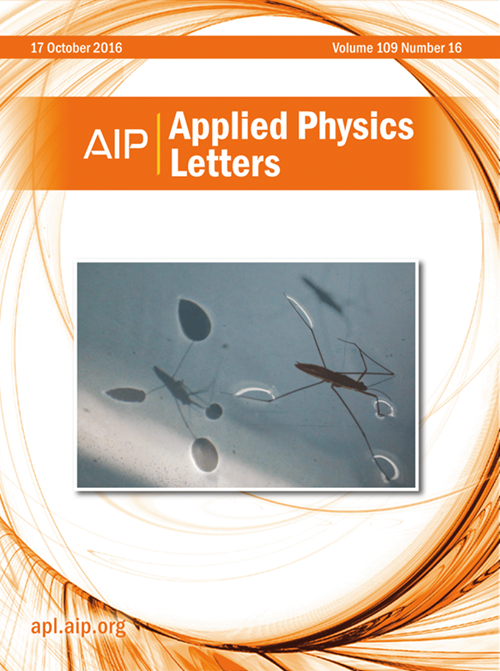Upper coherent interlayers using Cl-SnO2 for improved charge dynamics and efficient inverted perovskite photovoltaics
IF 3.5
2区 物理与天体物理
Q2 PHYSICS, APPLIED
引用次数: 0
Abstract
In recent years, inverted perovskite solar cells (IPVSCs) with a p–i–n structure have attracted widespread attention because of their easy fabrication, cost-effectiveness, suppressed hysteresis, superior operating stability, and low-temperature manufacturing techniques. The inorganic electron transport layers (ETLs) using tin oxide (SnO2) can replace the organic n-type materials to further enhance the device performance and operational stability. The SnO2 nanocrystals were prepared using perchloric acid and dispersed with organic solvents to form the Cl-bonded SnO2 solution. The coupling effect between the Cl-bonded SnO2 film and the Cl-containing perovskite precursor will form a coherent interlayer. This upper coherent interlayer will distinctly suppress charge non-radiative recombination and promote carrier extraction. The high crystallinity of the Cl-bonded SnO2 can also enhance fusion between grains, reduce grain boundaries, and improve the film conductivity. Here, the IPVSCs using all-metal-oxide charge transport materials (CTMs) have achieved the optimal performance with a power conversion efficiency of 23.26% (a VOC of 1.158 V, a JSC of 24.29 mA cm−2, and an FF of 0.827). The adopted all-metal-oxide CTMs can also improve the ambient stability, thermal stability, and light stability. In addition, the dynamic process (charge extraction and recombination) was analyzed in detail. The directly spin-coated Cl-SnO2 ETLs will provide a simple strategy for scalable preparation and commercialization of IPVSCs.使用Cl-SnO2改善电荷动力学和高效倒置钙钛矿光伏的上相干中间层
近年来,具有p-i-n结构的倒置钙钛矿太阳能电池(IPVSCs)因其易于制造、成本效益高、抑制迟滞、优越的工作稳定性和低温制造技术而受到广泛关注。利用氧化锡(SnO2)制备的无机电子传输层(etl)可以取代有机n型材料,进一步提高器件性能和运行稳定性。采用高氯酸法制备SnO2纳米晶,并用有机溶剂分散形成cl键合SnO2溶液。结合cl的SnO2薄膜与含cl的钙钛矿前驱体之间的耦合作用将形成一个相干的中间层。上层相干夹层明显抑制电荷非辐射复合,促进载流子提取。cl键合SnO2的高结晶度还可以增强晶粒间的融合,减小晶界,提高薄膜导电性。采用全金属氧化物电荷输运材料(CTMs)的IPVSCs达到了最佳性能,功率转换效率为23.26% (VOC为1.158 V, JSC为24.29 mA cm−2,FF为0.827)。采用的全金属氧化物CTMs还可以提高环境稳定性、热稳定性和光稳定性。此外,还详细分析了电荷提取和复合的动态过程。直接自旋涂覆的Cl-SnO2 etl将为ipvsc的可扩展制备和商业化提供一种简单的策略。
本文章由计算机程序翻译,如有差异,请以英文原文为准。
求助全文
约1分钟内获得全文
求助全文
来源期刊

Applied Physics Letters
物理-物理:应用
CiteScore
6.40
自引率
10.00%
发文量
1821
审稿时长
1.6 months
期刊介绍:
Applied Physics Letters (APL) features concise, up-to-date reports on significant new findings in applied physics. Emphasizing rapid dissemination of key data and new physical insights, APL offers prompt publication of new experimental and theoretical papers reporting applications of physics phenomena to all branches of science, engineering, and modern technology.
In addition to regular articles, the journal also publishes invited Fast Track, Perspectives, and in-depth Editorials which report on cutting-edge areas in applied physics.
APL Perspectives are forward-looking invited letters which highlight recent developments or discoveries. Emphasis is placed on very recent developments, potentially disruptive technologies, open questions and possible solutions. They also include a mini-roadmap detailing where the community should direct efforts in order for the phenomena to be viable for application and the challenges associated with meeting that performance threshold. Perspectives are characterized by personal viewpoints and opinions of recognized experts in the field.
Fast Track articles are invited original research articles that report results that are particularly novel and important or provide a significant advancement in an emerging field. Because of the urgency and scientific importance of the work, the peer review process is accelerated. If, during the review process, it becomes apparent that the paper does not meet the Fast Track criterion, it is returned to a normal track.
 求助内容:
求助内容: 应助结果提醒方式:
应助结果提醒方式:


